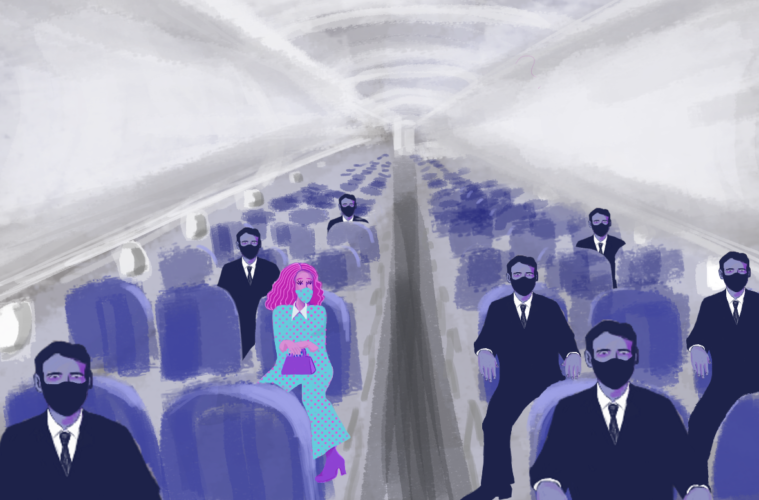Have you ever wondered what flying during a modern-day pandemic looks like? Let me help you out. If you expect to see people in hazmat suits and thermometers in every corner, I have a far more dystopian scene to offer: imagine boarding a plane with fifty people in facemasks – and none of them are women.
I did not realise the absence of women immediately, but I felt uncomfortable. I felt eyes on me. Whenever I looked at the Mexican Juarez Airport’s gate, I only encountered middle-aged men-gazes, looking at my leggings, my shirt. I saw a young woman sitting further back, and a mom at the front with her toddler, and no matter how many times I have recounted it, it was still just the three of us and at least fifty other men.
The whole time I was travelling back to Budapest (approximately 30 hours in total), I kept wondering where did all the women go? Sure, they were there: catering to passengers’ needs as stewardesses, cleaning ladies, and patient yet cheerful staff at the gates, but I could rarely spot them in the sea of thirty- and forty-something men.
But if you truly think about it, it’s not that surprising, is it? With countries around the globe closing and partially reopening their borders only for their citizens, you have to have a pretty solid reason to embark on a flight.
One reason for travelling could be an urgent business meeting that requires more physical formality that a Zoom meeting can offer; and if they need you in person, you must be a top executive or an established partner at a law firm.
According to concerning global statistics, women occupy only 5-20% of top leadership positions in fields like law, medicine, and finance as of 2019. This is despite the fact that women have outnumbered men on college campuses ever since 1988.
Let’s look at another factor: free time. The UN recently posted a study about how the pandemic affects women and girls all around the world, and while data can vary depending on the country observed, there is a definite global tendency: women do three times as much unpaid domestic labour than men. It’s caring for the children who are stuck at home due to remote-learning. It’s the girls who are forced to pitch in with the daily tasks at home while they are out of school. It’s the women juggling their own work (possibly remote as well), whilst managing household duties. It’s the caring for the elderly relatives, who had to move out of retirement homes, or whose treatments are temporarily suspended in hospital.
Historically, women have dutifully completed these socially-expected, “invisible” tasks, which are never really respected or compensated.
Additionally, there are women who can only dream about doing anything but their job. The pandemic shed light on many social inequalities, as well as the exploitation of doctors and nurses. Women represent 80-90% of the total number of nurses in the United States. Ever since March, hospitals all around the world have been overwhelmed, nurses and doctors are drained, physically and mentally. And to them, the next shift is either more unbearable hours at the intensive care unit, or going home and doing what women have to do.
And this is only the tip of the iceberg. The gender pay gap is stuck at a devastating 16%, and even 30% in some parts of the world. Due to restrictions, lockdown and quarantine, women, who make up the majority of the informal labour workforce (cleaning services, nannying, caring for elders), have lost their reliable source of income for an indefinite amount of time. And yet their work makes up 11 trillion dollars of the global economy each year.
Thinking all this through, it seems evident that women are taking fewer flights. Though these gender inequalities have been present for hundreds of years, they are so embedded in our everyday lives that they go unnoticed. The empty seats on my flight are not anomalies – they are merely reminders of women’s cruel reality.
Written by Tamara Csibra-Kaizer.
Currently studying English and Bibliotherapy in Budapest, her special field of study is the link between literature and mental health. She organizes open readings for aspiring writers, works both in Budapest and in Mexico.
Illustrated by Bogi Varga.

